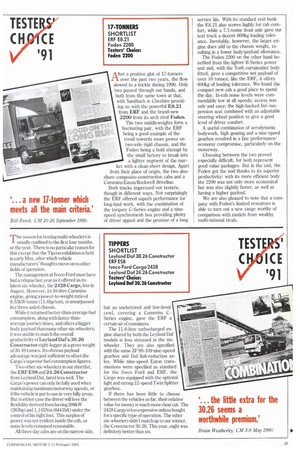17-TONNERS
Page 47

If you've noticed an error in this article please click here to report it so we can fix it.
SHORTLIST ERF E8.21 Foden 2200 Testers' Choice: Foden 2200
After a positive glut of 17-tonners II over the past two years, the flow slowed to a trickle during 1990. Only two passed through our hands, and both from the same town at that, with Sandbach in Cheshire providing us with the powerful E8.21
from ERF and the brand-new 2200 from its arch rival Foden. The two middleweights form a fascinating pair, with the ERF being a good example of the trend towards more power on two-axle rigid chassis, and the Foden being a bold attempt by the small factory to break into a lighter segment of the market with a clean-sheet design. Apart from their place of origin, the two also share composite-construction cabs and a Cummins/Eaton/Rockwell driveline. Both trucks impressed our testers, though in different ways. Not surprisingly the ERF offered superb performance for long-haul work, with the combination of the torquey C-Series engine and a ninespeed synchromesh box providing plenty of driver appeal and the promise of a long service life. With its standard rest bunk the E8.21 also scores highly for cab comfort, while a 7.1-tonne front axle gave our test truck a decent 600kg loading tolerance. Inevitably, however, the larger engine does add to the chassis weight, resulting in a lower body/payload allowance.
The Foden 2200 on the other hand benefited from the lighter B-Series power unit and, with the York curtainsider body fitted, gave a competitive net payload of over 10 tonnes; like the ERF, it offers 600kg of loading tolerance. We found the compact new cab a good place to spend the day. In-cab noise levels were commendably low at all speeds; access was safe and easy; the high-backed Isri suspension seat combined with an adjustable steering wheel position to give a good level of driver comfort.
A useful combination of aerodynamic bodywork, high gearing and a nine-speed gearbox resulted in a fine performance/ economy compromise, particularly on the motorway.
Choosing between the two proved especially difficult, for both represent good value packages. But in the end, the Foden got the nod thanks to its superior productivity: with its more efficient body the 2200 was not only more economical but was also slightly faster, as well as having a higher payload.
We are also pleased to note that a company with Foden's limited resources is able to turn out a new range worthy of comparison with models from wealthy multi-national rivals.




















































































































